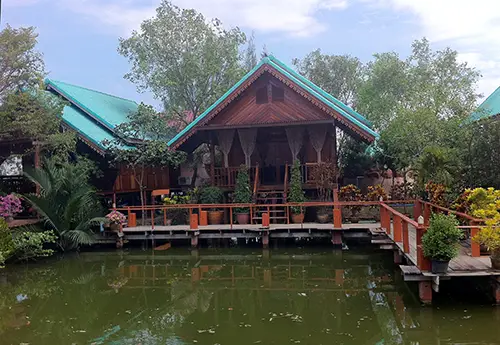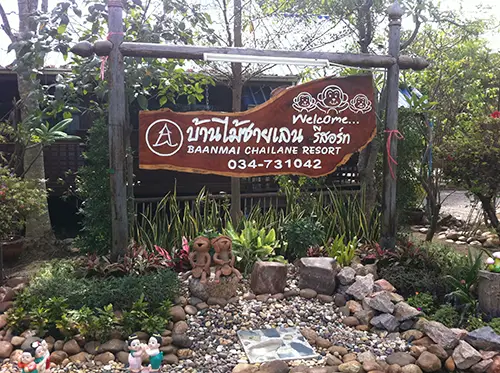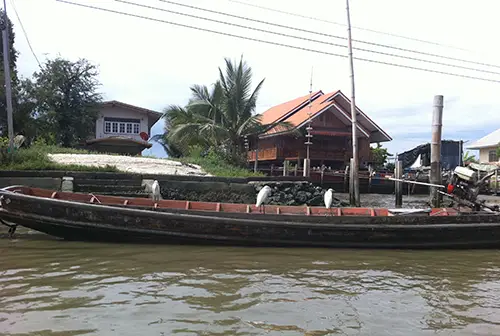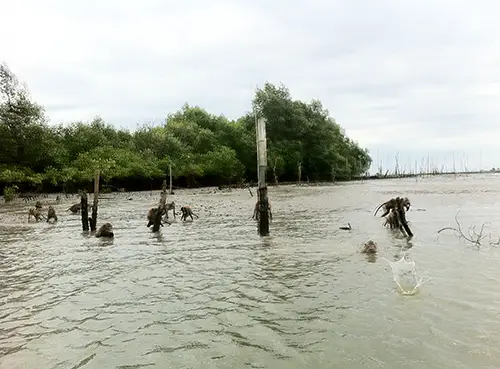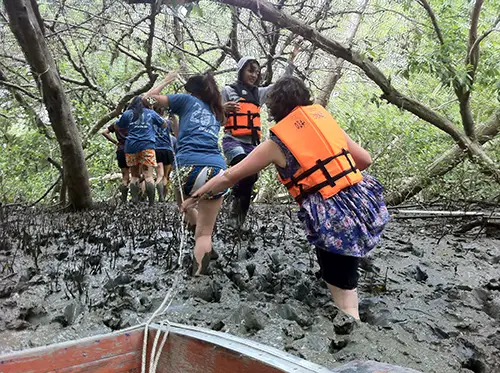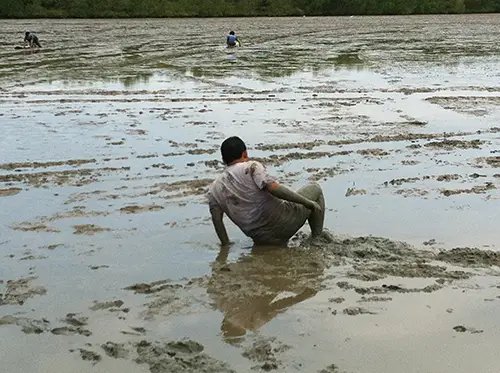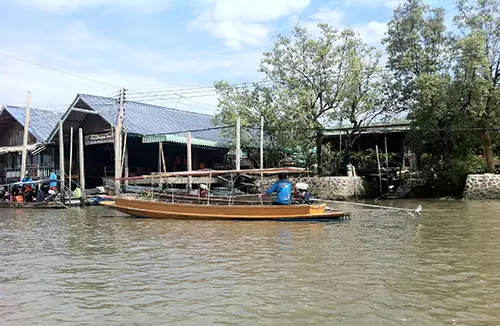As a general rule of thumb, traveling in Thailand involves visiting temples, museums and palaces; going shopping in street markets and malls; having drinks late at night at street restaurants or in fancy nightclubs; chilling out on the beach on the islands in the south; or hiking in the jungles in the north; or even riding an elephant and getting to feed them a few bananas! But, is there more to the Land of Smiles other than your usual touristy package?
If you’re willing to go off the beaten track and try out new things, then a weekend trip to Samut Sakhon, a province located in central Thailand, less than 50km southwest of Bangkok, is highly recommended. Of course, there as well, you will find plenty of temples to visit and seasonal festivals to attend, but Samut Sakhon offers much more.
As the name of the province suggests, most of the out-of-the-ordinary activities one can engage in during a visit to this province are dependent on the province’s vicinity to the Gulf of Thailand. The word “Samut” is of Sanskrit origin and means “ocean” whilst “Sakhon” derives from the Sanskrit word “sagara” which means “lake.” So, welcome to the “Ocean Lake” where, on a weekend escape, you can enjoy a boat ride and spy on monkeys playing on the riverbank, or you can get down and dirty in a mangrove forest (and even plant a tree there) and, for those looking for more thrills, even go mud surfing.
To organize all these things in advance, you’ll have to be able to speak quite a lot of fairly fluent Thai, but to make things much easier for everyone, Baanmai Chailane Resort is an viable option in case you want to have an enjoyable and hassle free trip. From here you can organize all your outings at reasonable prices and the people running the resort are friendly and reliable.
Upon arrival at your resort, check–in for your wooden bungalow, freshen up if needed and you’re ready to start your adventures.
Here’s a feasible and exciting itinerary for a two-day one-night trip to Samut Sakhon with the resort’s “four activities package”.
Start with a boat ride along the Tha Chin Klong River and explore the local community who still live in traditional wooden houses raised on stilts. You’ll notice that, instead of a pickup truck in front of their houses, most villagers have a long tail boat parked on the river, bobbing up and down as you speed by in your own boat. Fishing is the main livelihood for most villagers, so seeing the fishing nets hanging out to dry under the house and even some cranes resting on the eaves gives the place a tranquil and serene atmosphere.
The boat ride on the river can go on and on, and then it becomes past noon, and you’re getting hungry. Don’t panic! Your first stop will be at a restaurant located at the mouth of the river, where it flows into the Gulf of Thailand. The restaurant is basically just a wooden structure built on stilts with three huge dining areas. There you’ll sit on the floor in the traditional Thai style and have a copious meal made up of dishes which are all specific to this area of Thailand. Expect to eat lots of fish, seafood and fish curries. Plus, of course, the customary white rice.
While eating, you can enjoy an amazing view of the open water on one side and the line of mangrove forest on the other. Keep gazing at the ocean in the distance and listen to the screeching cries of the seagulls as they hunt for food. You’ll get your fair share of local mangroves, right after lunch.
Back on the boat, you’re set to visit the mangrove forest that blankets the coast and provides much needed protection from sea erosion and even from natural disasters. For example, during the 2004 Indian Ocean tsunami, mangrove forests were able to slow down the rushing colossal waves. As you enter the estuary, you’ll be greeted by packs of local monkeys that play in the shallow waters of the river.
Although they seem rather friendly and are not afraid of humans, be on the look out! On several occasions they have sneaked off with boat passengers’ possessions…Your boat driver will scare them away if they get too close, but if you have some fruit with you, you can throw it to the monkeys and see how skillful they are to open it and eat it.
Once you’ve reached deeper into the mangrove forest, it’s time to disembark. You’d be given advanced notice by the resort staff to basically wear clothes that you really don’t need any more and wear either flip-flops or, ideally, diving or climbing shoes with flexible but durable soles. You can also go barefoot if you dare, but be aware of random roots sticking out.
The moment you put your foot down on the muddy shore of the mangrove forest, you’ll immediately sink in knee-deep. It’ll be like this for another five to ten meters until you reach more solid ground, but don’t get frustrated when you fall face down in the mud. After all, you wanted a different kind of Thai experience, didn’t you?
Your boat driver will then take you farther into the mangrove forest to show you how to plant young mangrove trees which he has brought along from the resort. Mangrove restoration, or the regeneration of the mangrove ecosystem, and mangrove reforestation further down south (where the 2004 tsunami had wiped out entire forests and habitats) is of utmost importance for the future of both the local communities and that of the entire coastal area.
Apart from acting as a buffer zone preventing soil erosion, mangrove forests are a breeding ground for several marine organisms, such as shrimps, crabs and small fish which have a tremendous economic value. Planting even a few mangrove trees today can have a great positive impact for the future. So, don’t fret about getting your hands dirty. Just do your duty as a world citizen! Also, while you’re at it, keep an eye open for the weird pla teen, a very peculiar species of fish that has feet and lungs and is also known as the mudskipper or “walking fish.”
Getting back onto the boat can be an even bigger challenge but once back on board and covered in mud from ear to toe, you’re off to the surfing ground. Yes, there’s a place in Samut Sakhon where you can go mud surfing. Your boat driver will pull out from under your seat a surfboard which can hold up to three small people and, with some skill, you can even slide for a few meters on the mud. Obviously, you’ll get even more mud all over yourself, but once you’re done with this exhausting extreme sport (it requires a lot of patience and energy to learn the tricks of successful mud surfing) you can just dip in the seawater to wash off some of the mud and sticky slime.
If you brought a camera and managed to keep it clean and dry, you’ll have a chance to take some amazing photographs at sundown, just before you make your way back to the resort.
On the next day, on your return trip back to Bangkok, you can also stop along the way at the Shellfish Farm, the floating market on Damnoen Saduak Canal, and the Wichian Chodok Fortress. Just follow the road signs or Google Maps.
How to get to Samut Sakhon
Going to Samut Sakhon is really easy. If you have a car, then cross the Chao Phraya River into Thonburi and then follow the road signs. You can also take the bus from the Southern Bus Terminal or the train from Wongwian Yai Station (disembark at Maha Chai Station). Once in Samut Sakhon, you can move around by using either tuk tuk, motorbike taxi or even using the ancient samlor (rickshaw), but make sure you ask what the fee will be in advance! Make that trip and enjoy true nature! It is a very worthwhile escape from the city life.
